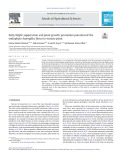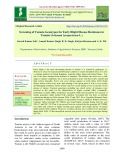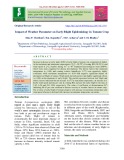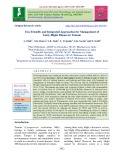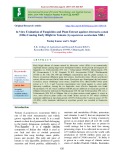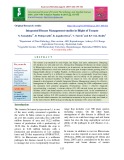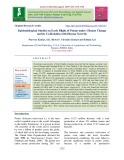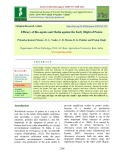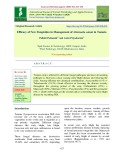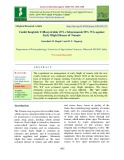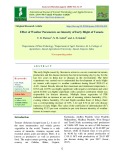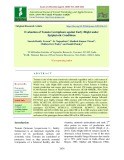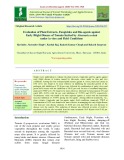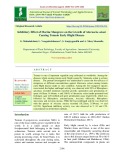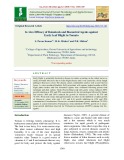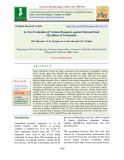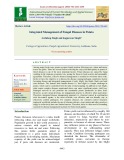
Early blight disease
-
Induction of acquired resistance activates defense-related genes. Current study aimed to (a) initiate potato acquired resistance to the Early Blight disease caused by Alternaria solani through treating potato plants with low and repetitive doses of 2,4-dichlorophenoxy acetic acid (2,4-D), abscisic acid (AB)
 9p
9p  schindler
schindler
 30-12-2021
30-12-2021
 9
9
 0
0
 Download
Download
-
In the current work, A. flavus as an herb endophyte was selected to verify its role as plant growth-promoting and protection such as antimicrobial activity, IAA production, phosphorus solubilization and nutritional improvement of the tomato plant. So far, there is no previous investigation has been done on evaluating the potential of A. flavus as tomato plant growth promotion and to control Alternaria early blight disease of tomato.
 7p
7p  schindler
schindler
 30-12-2021
30-12-2021
 12
12
 0
0
 Download
Download
-
Early blight is the most devastating disease of tomato it is caused by pathogens i.e. Alternaria solani. In tropical and subtropical countries it creates hazardous effect. It is also a common problem in United Kingdom, Australia, India, Nepal and United States. It is one of the most common foliar diseases of tomatoes. The disease can occur over a wide range of climatic conditions, but is most prominent in areas with heavy dew, rainfall and high relative humidity. Every year sever disease appears in north India.
 6p
6p  chauchaungayxua10
chauchaungayxua10
 19-03-2021
19-03-2021
 18
18
 3
3
 Download
Download
-
With an aim to find out the role of various weather factors on infection and development of early blight in tomato, the study was conducted.
 7p
7p  nguaconbaynhay10
nguaconbaynhay10
 22-01-2021
22-01-2021
 6
6
 1
1
 Download
Download
-
Hence the present investigation based on an integration of biological and cultural methods of blight and fruit rot management in tomato.
 6p
6p  cothumenhmong9
cothumenhmong9
 04-01-2021
04-01-2021
 14
14
 2
2
 Download
Download
-
Keeping in view of above facts present experiments were conduct on “in vitro efficacy of fungicides against Alternaria solani causing early blight disease in Tomato (Lycopersicon esculentum Mill.)”.
 8p
8p  angicungduoc8
angicungduoc8
 07-11-2020
07-11-2020
 9
9
 1
1
 Download
Download
-
The present investigation was undertaken during 2012 to 2014 at Department of Plant Pathology, C.S.A. University of Agriculture and Technology, Kanpur. The pathogen A. solani was isolated from diseased plant showing typical blight symptoms collected from Vegetable Research Farm, Chandra Shekhar Azad University of Agriculture and Technology, Kanpur, Uttar Pradesh, India.
 11p
11p  nguathienthan8
nguathienthan8
 20-10-2020
20-10-2020
 13
13
 1
1
 Download
Download
-
The tomato crop attacked by early blight, late blight, leaf spots, anthracnose, Dampimg off, buckeye rot, wilts and root rots. Among these Damping off diseases in tomato caused by Rhizoctonia solani is very common to see in nurseries, an increased incidence of blight caused by Rhizoctonia solani was noticed in recent past in major tomato growing areas of Ranga Reddy district of Andhra Pradesh.
 7p
7p  nguathienthan8
nguathienthan8
 20-10-2020
20-10-2020
 11
11
 2
2
 Download
Download
-
Occurrence and severity of Early blight of potato observed that the disease occured every year at Kanpur and Faizabad district of Utter Pradesh. It has observed that the disease was first appeared during 2–3 rd weeks of December at Kanpur and 3rd weeks of December to 1 st weeks of January at Faizabad district of Uttar Pradesh at the maximum temperature range 17–230C, minimum temperature 1.8–7.80C, relative humidity 46–93%, and 0–7.2 sun shine hours. The maximum severity with 28.
 12p
12p  cothumenhmong7
cothumenhmong7
 08-09-2020
08-09-2020
 7
7
 1
1
 Download
Download
-
Early blight of potato caused by Alternaria alternata is one of the major diseases causing considerable yield loss. Efficacy of bio-agents was studied and revealed the all four Trichoderma species significantly reduced the mycelial growth of the pathogen over the control by dual culture method. Significantly maximum inhibition of mycelial growth was obtained with T. viride (57.08%) followed by T. azospirillum (50.00%), T. harzianum (43.26%) and T. virens (37.08%) of the pathogen after 48 hours of incubation. In present study, T. viride was observed more inhibitory against A. alternata...
 6p
6p  kethamoi7
kethamoi7
 26-08-2020
26-08-2020
 11
11
 2
2
 Download
Download
-
Tomato crop is affected by different fungal pathogens and most devastating pathogen is Alternaria solani causing early blight disease and reducing the yield. Among different new chemical combinations, Azoxystrobin (11%) + Tebuconazole (18.3%) found effective in lowering the disease severity throughout the growing period of the crop.
 4p
4p  nguaconbaynhay7
nguaconbaynhay7
 15-08-2020
15-08-2020
 12
12
 1
1
 Download
Download
-
The experiment on management of early blight of tomato with the new combi molecule was conducted during Kharif 2018 in the bio-resource farm of Institute of organic farming, University of Agricultural Sciences, Dharwad. The new molecule and market sample of Trifloxystrobin 25%+Tebuconazole 50% WG, Azoxystrobin 23% SC, Copper Oxychloride 50% WP were evaluated against early blight incidence. The above chemicals sprayed two times at 15 days interval.
 7p
7p  caygaocaolon6
caygaocaolon6
 30-07-2020
30-07-2020
 12
12
 2
2
 Download
Download
-
The early blight caused by Alternaria solani is a severe constraint in tomato production and the disease intensity has been increasing day by day for the last few years in India due to changes in the environment. The field experiment was carried out to understand the development of early blight on tomato with respect to weather conditions during kharif 2018-19 at AAU, Anand.
 6p
6p  angicungduoc6
angicungduoc6
 22-07-2020
22-07-2020
 7
7
 1
1
 Download
Download
-
Tomato is one of the most extensively cultivated vegetables and is a rich source of nutrients such as vitamins, antioxidants and minerals for a balanced human diet. World over, early blight (EB) caused by Alternaria solani Sorauer is limiting tomato production and causes great losses. In total, 350 tomato genotypes from ICAR-National Bureau of Plant Genetic Resources (ICAR-NBPGR), New Delhi were evaluated for early blight resistance under epiphytotic conditions at ICARIndian Institute of Vegetable Research (ICAR-IIVR), Varanasi.
 7p
7p  angicungduoc6
angicungduoc6
 22-07-2020
22-07-2020
 15
15
 0
0
 Download
Download
-
Studies were undertaken to evaluate the plant extracts, fungicides and bio-agents against early blight disease of tomato caused by Alternaria solani under in vitro and vivo conditions. Among the four evaluated plant extracts against A. solani, neem leaf extract at 15% (w/v) was found to be most effective in inhibiting the mycelial growth of the pathogen with inhibition of 52.36 per cent, followed by combination of garlic clove and green chilli extract with the inhibition of 50.42 per cent.
 7p
7p  angicungduoc6
angicungduoc6
 22-07-2020
22-07-2020
 17
17
 1
1
 Download
Download
-
Tomato is one of important vegetable crop cultivated in worldwide. Among the diseases which causing tomato early blight caused by Alternaria solani is serious disease. The present investigation was undertaken to assess the bio-efficacy of mangroves at different concentrations against Alternaria solani causing tomato early blight disease under in vitro condition.
 7p
7p  angicungduoc6
angicungduoc6
 22-07-2020
22-07-2020
 14
14
 1
1
 Download
Download
-
Turcicum leaf blight (TLB) or Northern Corn Leaf Blight (NCLB) is a ubiquitous foliar disease of corn (maize) caused by Exserohilum turcicum, the anamorph of the ascomycete Setosphaeria. The TLB fungus survives through the winter on infected maize residue at the soil surface. As temperatures rise in the spring and early summer, the fungus produces spores on residue, and then the spores are splashed or wind-blown onto leaves of the new maize crop. Infection occurs during periods of moderate (64° to 81°F), wet and humid weather.
 7p
7p  chauchaungayxua6
chauchaungayxua6
 26-06-2020
26-06-2020
 17
17
 1
1
 Download
Download
-
Early blight is potentially destructive disease in tomato occurring on the oldest leaves as small, brownish which are due to foliar blight disease and it was caused by a foliar fungal pathogen Alternaria solani. The disease causes considerable yield as well as post-harvest losses. A. solani produced blackish, fluffy mycelium with septate, beaked conidia on PDA Eight plant extracts and four biocontrol agents were evaluated following poison food technique and dual culture.
 6p
6p  quenchua6
quenchua6
 15-06-2020
15-06-2020
 8
8
 2
2
 Download
Download
-
Biotic and abiotic stresses are major constraints in the production of groundnut. Among biotic stresses apart from bacterial and viral diseases, many fungal diseases are of economic importance. The major fungal diseases are Early leaf spot (Cercospora arachidicola), Late leaf spot (Cercosporidium personatum), Rust (Puccinia arachidis), Botrytis blight (Botrytis cinera), Aflarot/Yellow mould (Aspergillus flavus), Damping off (Pythium spp.
 7p
7p  nguathienthan5
nguathienthan5
 04-06-2020
04-06-2020
 16
16
 0
0
 Download
Download
-
Among major food crops, potato occupies fourth position following rice, wheat and maize across the globe. There are several factors affecting the crop yield and quality in potato of which disease is one of the most important factors. Potato diseases are caused by fungi resulting in the immense economic loss, posing the threat to food security and sustainable agriculture. Therefore, effective disease management is essential to overcome these risks.
 8p
8p  trinhthamhodang1213
trinhthamhodang1213
 29-05-2020
29-05-2020
 7
7
 0
0
 Download
Download
CHỦ ĐỀ BẠN MUỐN TÌM










